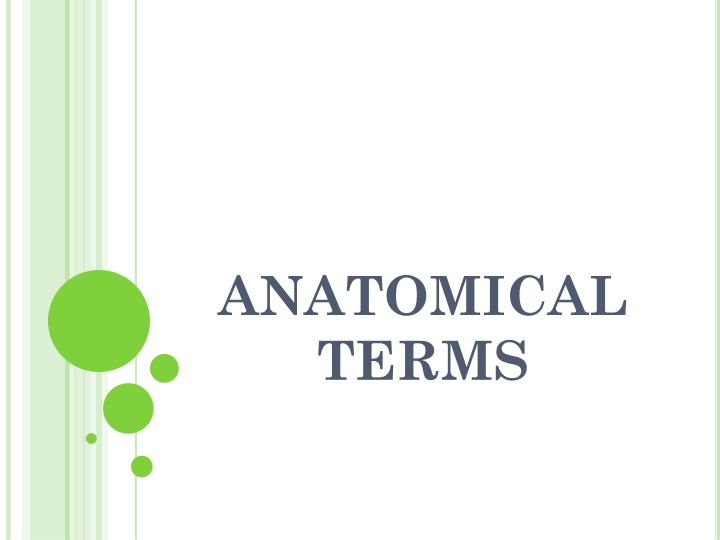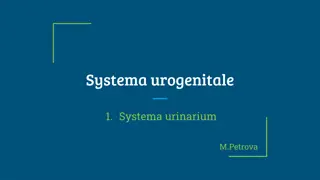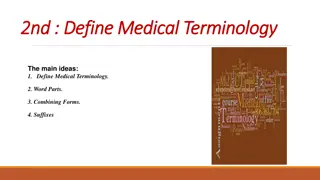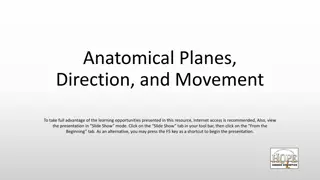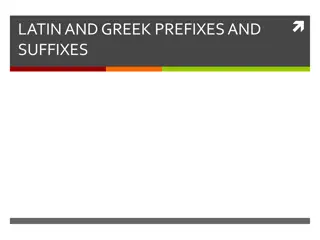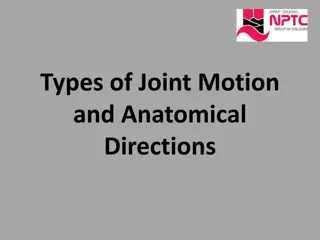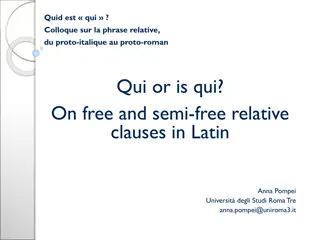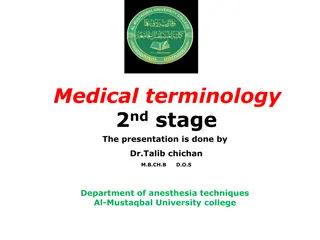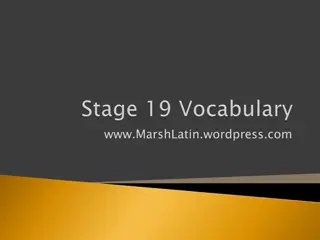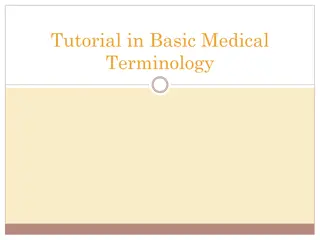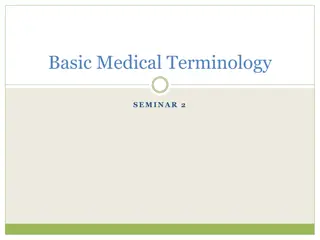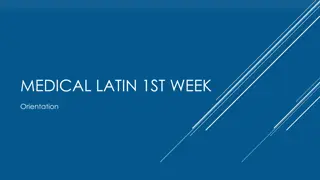Anatomical Terminology Evolution: From Latin to Modern Standards
Anatomical terms have evolved over centuries into a unified nomenclature system known as Nomina anatomica. This system, initially based on Latin and Greek words, faced confusion and disagreement among anatomists, leading to revisions and the introduction of modern anatomical terminology. The structuring of anatomical terms can range from simple one-word terms to multi-word terms. This evolution culminated in the establishment of Terminologia Anatomica in 1998 by the International Anatomical Nomenclature Committee.
Download Presentation

Please find below an Image/Link to download the presentation.
The content on the website is provided AS IS for your information and personal use only. It may not be sold, licensed, or shared on other websites without obtaining consent from the author.If you encounter any issues during the download, it is possible that the publisher has removed the file from their server.
You are allowed to download the files provided on this website for personal or commercial use, subject to the condition that they are used lawfully. All files are the property of their respective owners.
The content on the website is provided AS IS for your information and personal use only. It may not be sold, licensed, or shared on other websites without obtaining consent from the author.
E N D
Presentation Transcript
ANATOMICAL TERMS
ANATOMICAL TERMINOLOGY Anatomical nomenclature (Nomina anatomica) is a scientifically unified register of anatomical terms used in medicine and biology, which is formed according to the body system. The anatomical term is a word used to name a definite unit or structure of a human body. Anatomical terms were created during centuries on the ground of languages. The nomenclature consists mainly of Latin words, but Greek terms are also used among them. Greek modern and anatomical Latin
In the late 19-th century some 50 000 terms for various body parts were in use. The same structures were described by different names, depending (among other anatomist s school and national tradition. things) on the There was disagreement and confusion among anatomists regarding anatomical terminology. In 1887 the revision of modern anatomical terminology was initiated.
A congress of the Anatomische Gesellschaft (Anatomical society) in Basle in 1895 Baseler Nomina Anatomica (BNA). The register of anatomical terms was checked and renewed in Jena in 1935 (Jenaer Nomina Anatomica JNA, that was used only in Europe). Congresses of Anatomists: in Paris in 1955 (Parisiana Nomina Anatomica PNA); in Montreal 1987, in Budapest 1988, in New York 1989, in Sao Paolo 1997. The last edition, called Terminologia Anatomica, was introduced by the International Anatomical Nomenclature Committee and published in 1998.
STRUCTURE OF ANATOMICAL TERMS Anatomical terms may consist of one, two, three, four and more words (up to 8). 1. One-Word Terms (monomial): a. simple; b. composed. 2. Two-Word Terms (binomial): a. two nouns in singular or plural; b. a noun with an adjective. 3. Three-Word Terms: a. three nouns; b. a noun and two adjectives; c. two nouns and an adjective. 4. Multiword Terms.
ONE-WORD TERMS (MONOMIAL) 1.One-Word Terms (monomial): a. simple expressed by one word: ulna elbow bone; humerus humeral bone; cuneus wedge; caput head; tuber tuber; facies surfasce, costa rib, costae ribs. b. composed formed by two or more stems using linking vowels -o or -i: humeroulnaris humeroulnar, cuneonavicularis cuneonavicular, cuneiformis cuneiform; scaphoideus scaphoid.
TWO-WORD TERMS (BINOMIAL) Two-Word Terms (binomial) are composed of a noun and a modifier, which concretizes the noun. Modifier always follows the noun. May consist of: a. two nouns in singular or plural: corpus vert brae body of vertebra, corp ra vertebr rum bodies of vertebrae; os coccyges coccygeal bone. b. a noun with an adjective: vert bra thorac ca thoracic vertebra; cornu coccygeum coccygeal horn.
THREE-WORD TERMS Three-Word Terms may consist of: a. three nouns: ligamentum tuberc li costae ligament of tubercle of rib; b. a noun and two adjectives: processus articul ris super or superior articular process; c. two nouns and an adjective: sulcus nervi spin lis furrow of the spinal nerve.
GRAMMATICAL CATEGORIES OF A NOUN Genus (gender): mascul num (masculine), femin num (feminine) neutrum (neuter). Numerus (number): singul ris (singular) plur lis (plural). Casus (case): Nominativus (nominative) Genetivus (genitive) Dativus (dative) Accusativus (accusative) Ablativus (ablative) Vocativus (vocative)
DICTIONARY FORM OF A NOUN The dictionary form of a noun consists of three components: 1. the full form of Nominative singular; 2. the Genitive singular ending; 3. the designation of gender (with the letters m, f, n). ala, ae f wing; sternum, i n breast bone; ductus, us m duct.
DECLINATIO (DECLENSION) There are five declensions in Latin; that is, five categories of nouns, each with its own endings. Declinatio prima (First declension) costa, ae f rib vert bra, ae f vertebra Declinatio secunda (Second declension) nasus, i m nose collum, i n neck olecr non, i n tip of the elbow cancer, cri m cancer Declinatio tertia (Third declension) can lis, is m canal reg o, nis f region os, ossis n bone Declinatio quarta(Fourth declension) arcus, us m arch cornu, us n horn Declinatio quinta (Fifth declension) fac es, i f surface, face
Declinationes Numerus / Casus I II III IV V -a (f) -us, -er different -us (m) -es (f) (m) (m, f, n) -u (n) Singularis Nom. -um (n) -ae -i -is -us -ei Gen. -ae -i -es -us -es Pluralis Nom. -a -(i)a -ua - rum - rum -(i)um -uum - rum Gen.
THE NOUN AS NON-AGREED MODIFIER
Determine the declension of nouns: cor, cordis n __ lien, lienis m __ caput, itis n __ palatum, i n __ pilus, i m __ pes, pedis m __ membrum, i n __ paries, etis m __ fornix, icis m__ dies, ei m, f __ natura, ae f __ lens, lentis f __ glandula, ae f __ os, oris n __ tuba, ae f __ pelvis, is f __ cartilago, inis f __ crista, ae f __ calvaria, ae f __ scabies, ei f __
Determine the declension of the nouns: facies, i f (surface); nervus, i m (nerve); for men, nis n (opening); ligamentum, i n (ligament); tempus, ris n (temple, time); articulatio, nis f (joint); cartil go, nis f (cartilage); meniscus, i m (meniscus); magister, tri m (teacher); sphincter, ris m (sphincter); colon, i n (part of large intestine); plexus, us m (network, chiefly of veins or nerves); tuber, ris n (thickend portion of underground stem; rounded swelling); diaphragma, tis n (septum between thorax and abdomen, diaphragm). pars, partis f (part); ramus, i m (branch); can lis, is m (canal); dens, dentis m (tooth); genu, us n (knee); ala, ae f (wing); cervix, cis f (neck);
Find the stem of nouns: metacarpus, i m lobus, i m phalanx, ngis f coccyx, ygis m porta, ae f rete, is n spina, ae f sutura, ae f textus, us m stroma, atis n medulla, ae f os, ossis n vermis, is m pyramis, idis f plexus, us m ren, renis m systema, atis n truncus, i m tela, ae f species, ei f
Complete the terms and translate into English: sutura, ae f / cranium, ii n cavitas, atis f / thorax, acis m dorsum, i n / pes, pedis m cingulum, i n / membrum, i n digitus, i m / manus, us f regio, onis f / caput, itis n trigonum, i n / femur, oris n basis, is f / os, ossis n septum, i n / sinus, us m corpus, oris n / maxilla, ae f vena, ae f / porta, ae f meatus, us m / nasus, i m _ facies, ei f / tuberculum, i n hiatus, us m / canalis, is m
Put nouns into Gen. sing.: fossa, ae f digitus, i m ligamentum, i n caput, itis n os, ossis n ductus, us m genu, us n facies, ei f ulna, ae f ramus, i m membrum, i n corpus, oris n sinus, us m processus, us m cornu, us n caries, ei f
Pay attention to the word order: spina scap lae (spine of shoulder bone); raphe pal ti (suture of palate); skel ton membri (skeleton of a limb); ossa cranii (bones of skull); fossa gland lae (cavity of gland); vena portae (portal vein); septum nasi (dividing wall of nose); crista tuberc li (crest of tubercle); processus radii (appendix of radial bone); caput fib lae (head of fibular bone); corpus tibiae (body of shin bone); facies acromii (surface of acromion); linea nuchae (line of neck nape); sulcus sinus (furrow of sinus); basis cranii (base of skull); ang lus mandib lae (angle of lower jaw).
Pay attention to the word order: collum costae (scap lae) (neck of rib (shoulder blade)); corpus fib lae (hum ri, maxillae, tibiae) (head of fibular bone (humeral bone, upper jaw, shin bone)); Incis ra mandib lae (scap lae) (notch of lower jaw (shoulder blade)); radix dentis (linguae) (root of tooth (tongue)); ang lus costae (mandib lae) (angle of rib (lower jaw))
Make up the dictionary form of nouns: arcus (arch), concha (concha), sulcus (furrow or groove), nasus (nose), scap la (shoulder blade), septum (dividing wall), collum (neck), org non (organ), musc lus (muscle), genu (knee), lingua (tongue; language), fossa (shallow depression or cavity), colon (part of large intestine), olecr non (elbow appendix), bulbus (bulb; any rounded mass), pleura (membrane lining chest and covering lungs), tuberc lum (tubercle; small rounded swelling). sinus (cavity, sinus), incis ra (slit ornotch), cornu (horn), amnion (amnion), ad tus (enter), ganglion (nerve node), porus (opening, pore), enceph lon (brain), ramus (branch), nodus (node),
